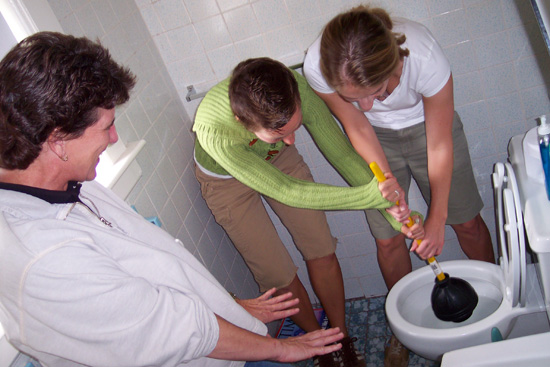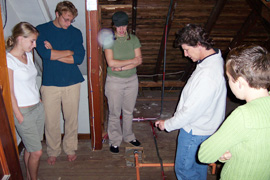WesHome Program Teaches Students How to Live
 |
| Barbara Spalding, associate director of Campus Fire Safety, teaches housemates Sally Smyth ’07 and Kara Brodgesell ’07 how to plunge a toilet and shut off a water valve at their student residence as part of the WesHome Program. |
| Posted 10/05/06 |
| Home sweet home. Or is it?
If a students residence is too hot, has a broken toilet, a burned-out entrance light, sticky windows or drafty doors, his or her home may not be more sour than sweet. WesHome, a new program spearheaded by Physical Plant and the Campus Fire Safety Office, teaches students how to use, maintain and be safe in their Wesleyan habitats. Wesleyan currently has 143 wood-framed homes, which house more than 554 students. Already, about 40 Wesleyan staff members have adopted their own WesHome. At Wesleyan we teach students all kinds of things, but we havent educated them how to live in their homes, says Barbara Spalding, associate director of Campus Fire Safety. On Sept. 29, Spalding visited the six students living in the 88 Home Ave. house. She brought along a pizza, soda, cookies and a plunger. Does everyone know how to use this thing, she asks, smiling.
Spalding then goes down a checklist, making sure their keys, doors, lights, windows, appliances, exhaust fans and heating system work. She explains where they are able to park, where their fire extinguishers are, when trash and recyclables are collected, how to close a storm window, how to hang a shower curtain inside the bathtub and how to control their thermostat. She talks about prohibited items and behaviors such as using candles, burning incense, the use of electric heaters and halogen floor lamps, or placing furniture too close to the heaters. Basements and attics are locked and Spaulding reminds students that unauthorized access to these areas will lead to a $500 fine. Heating issues alone are worthy of an extensive talk. Spalding estimates that half of the students living in Wesleyans wood-framed homes have no idea where their homes thermostat is located. Before you call Physical Plant and say your home is too hot or too cold, make sure your thermostat is set at a comfortable temperature that everyone in your home can agree on, Spalding says. Fixing the heat is not usually a housing problem, its a behavior problem. Spalding proceeds with a home tour, showing the residents their boiler, electric box and fire alarm panel in the basement. She teaches the residents how to plunge a toilet and shut off a water valve. Residents also receive an Emergency Planning Notebook, which contains a photo of the home, exit plans, emergency phone numbers, links to personal safety Web sites, Emergency Blue Light locations, fire alarm and sprinkler information, trash and recycling information, energy saving tips, cable modem information and a family-contact emergency form for each of the homes residents. Meredith Katz, an 88 Home Avenue resident, says she enjoyed learning how her home away from home works. Our home-mom, Barbara, taught us everything we need to know about maintaining a happy household, she says. Now we know how to respect and preserve our beautiful home. The WesHome program is seeking staff and faculty volunteers to adopt a home. For more information, contact Barbara Spalding at 860-685-3780. |
| By Olivia Drake, The Wesleyan Connection editor |


 After a brief introduction, Spalding gathers with the students in their living room. She asks if the students are having any problems with their home, and takes note of their concerns. Any immediate problems are reported to Physical Plant.
After a brief introduction, Spalding gathers with the students in their living room. She asks if the students are having any problems with their home, and takes note of their concerns. Any immediate problems are reported to Physical Plant.